A new study has uncovered the origins of the sun’s turbulent solar wind, revealing that the chaos begins deep within the sun’s corona. This breakthrough sheds light on the complex dynamics of our star and could help us better understand and predict space weather.

Unraveling the Solar Wind’s Turbulent Roots
However, the solar wind from the sun is nothing like a gentle breeze. It is not the smooth undulating flow of electric current it ought to be; instead, a turbulent gusty stream of charged particles that hurtles relentlessly through our solar system in reaction to the sun’s forever-shifting magnetic field.
For decades, astronomers have thought that this turbulence is born in the sun’s corona, the outermost layer of the solar atmosphere. However, they have never had the technology to observe this process firsthand — until now.
Researchers were able to observe the entire development of solar wind turbulence in high-resolution images for the first time, thanks to the Metis coronagraph instrument installed on ESA’s Solar Orbiter. Metis could, in fact, while dimming the sun’s bright glare, see through it to pick up more subtle yet important movement dynamics within the corona mapping how small disturbances emerge as full-scale turbulence in the solar wind heads outwards.
The discovery represents the first direct observation and most clear-cut evidence yet for fully developed turbulence in this part of the sun’s corona, also providing a glimpse into the way that energy dissipates to create heat and enahnce solar wind flowing from the sun.
Unraveling the Secrets of Space Weather
The turbulence of the speed of the solar wind is instrumental to predict and alleviate possible space weather effects influencing not only Earth but also our infrastructures.
When the solar wind reaches the magnetic fields of planets and moons, it can create geomagnetic storms, which can interfere with communications; lead to satellite mishaps; or shut down power grids. Pinpointing where this particular turbulence comes from will help them model that change, which in turn should lead to better forecasts of impending space weather and prepare for how best to avoid harm from it.
This research demonstrates some of the new puzzles that the Metis coronagraph will be able to help solve as it provides important new perspectives on how turbulence in solar wind is created and dissipated, from tiny fluctuations in the sun’s atmosphere out to the complex flow patterns observed throughout Heliosphere. Armed with this new knowledge, researchers can work on refining models and increasing our ability to predict and manage the damage that space weather could cause to our technology and lives.
This research provides new ways of delving in the intricate dynamics and behavior of the Sun’s atmosphere leading to an improvement in our comprehension levels of the star located at the heart of our solar system.
Conclusion
The newfound origin of turbulence within the sun’s corona has clear implications for enhancing our knowledge about solar physics and how this research pertains to the external space environment. With this key to where the rough air comes from, researchers can now more accurately model and predict space weather problems that can damage our technology and lives. The findings may also help reveal the inner workings of our sun, offering a rare glimpse of how dynamic processes drive much of the activity within our solar system.
